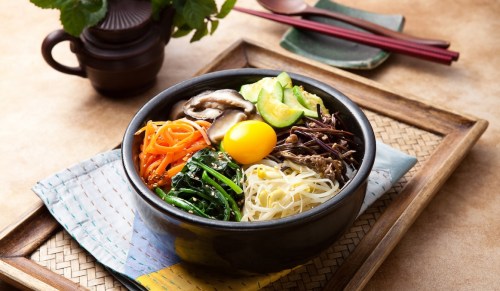Worldwide interest in Korean culture isn’t limited to K-pop, K-dramas, and 10-step skincare routines. Of all the yummy foods on the planet, everyone seems to be searching for a bibimbap recipe. In fact, bibimbap—a Korean rice bowl with veggies, fermented sauces, and a variety of fixings—landed the top spot of globally searched recipes in 2023.
Experts in This Article
registered dietitian and author of The MIND Diet
So why might bibimbap recipes, in particular, be surging in popularity as of late? “Bibimbap is comfort food, and everyone loves comfort food,” shares Maggie Moon, RD, a Korean–American dietitian and brain health nutrition expert for MIND Diet Meals. “People are curious about global flavors, and bibimbap is a beginner-friendly way to explore Korean cuisine.”
Because you can mix and match leftover ingredients and pantry and fridge staples, bibimbap is also appealing for its practical and accessible nature. In other words, bibimbap won’t only take your taste buds on a culinary journey to the Far East, but it also allows you to add your own spin to the dish and helps cut down on food waste.
Ahead, learn more about this nutritious and highly customizable Korean dish. Then, learn how to whip it up at home with Moon’s own bibimbap recipe.
What is bibimbap?
“Bibimbap means mixed rice,” Moon explains, with bap being the Korean word for rice. “After rice, the most popular ingredients include veggies like spinach, bean sprouts, carrots, and mushrooms, but I’ve also had bibimbap with zucchini, fernbrake, and bellflower roots,” she says. Next up, Korean sauces, typically based in gochujang (spicy fermented red chili paste), are non-negotiable. So long as you include these foundational ingredients, you can pretty much direct your own foodie adventure from there.
“Bibimbap can be adapted to whatever leftovers you have in your refrigerator,” Moon continues. For example, you can add whatever vegetables you have on hand and various sources of protein, whether from animals (meat and/or an egg) or vegan-friendly sources.
Health benefits of bibimbap
Because bibimbap includes a variety of vegetables and whole grains, you’ll get a diversity of nutrients with each recipe you whip up. “Bibimbap is a great vehicle for whole grains. This can be any kind of rice, but brown rice or a multigrain rice is a great way to add antioxidants and gut-friendly dietary fiber to the dish,” says Moon.
The colorful veggies also make it an easy way to eat the rainbow (or at least a few different hues) and reach the ultimate goal of eating 30 plants per week—the ideal target for a healthy gut microbiome, according to research by the American Gut Project. Unfortunately, only one in 10 American adults consume the amount of produce recommended by the Centers for Disease Control and Prevention. But a single serving of bibimbap, depending on how you build it, can make a major dent on these quotas.
“The variety of colors means you are getting a variety of polyphenol antioxidants that protect the body from harmful molecules. Research shows that a diet high in anti-inflammatory polyphenols is associated with better mental and cognitive health,” Moon explains.
If you’re an omnivore, throwing in a small serving of meat can strike an ideal ratio of plants to animal foods. “Bibimbap can be made with thinly sliced lean beef or ground turkey as one of the toppings—usually seasoned and cooked with some garlic and green onions,” Moon shares. She also calls out the merits of including an egg, which not only provides six grams of protein but also the antioxidant lutein and memory-supporting choline.
5 Tips to make your own bibimbap recipe
There are many ways to prepare your own bibimbap recipe at home, but here are some tips to help you get started, including Moon’s recipe below.
“There are 10+ plants in this one-bowl balanced meal, including five out of the 10 recommended brain-boosting MIND foods: whole grains, leafy green vegetables, additional vegetables, olive oil, and beans,” she says. However, she invites you to modify the recipe depending on your own dietary preferences and whatever you have on hand.
1. Switch up the veggies
The ideal bibimbap bowl has at least three colorful vegetables, which are sliced into short matchsticks or other small shapes, Moon says. “A pared down version of this recipe [below] is just as delicious and nutritious with spinach, carrots, soybean sprouts, mushrooms, and an egg in addition to the rice and the sauce,” Moon says. Some other colorful veggies she suggests adding into the mix include chopped broccoli, matchstick bell peppers, and cucumbers.
2. Substitute plant-based protein
Though topping bibimbap with an egg is common and Moon uses it in her recipe, she also suggests adding braised black beans, soybean sprouts, and/or seasoned tofu for additional plant-based protein.
3. Diversify your grains
You can use brown or multigrain rice to build your bowl. Moon recommends using 5- or 7- or 9-grain blends, which you can find at Korean grocery stores.
4. Add more Korean flavors
Whether you make or buy additional Korean staples—namely banchan (Korean side dishes) and other seasoned toppings—including them in bibimbap is a wonderful way to enjoy them. For instance, you can always include some fermented fare like kimchi—the mouth-puckering national dish of South Korea—to double down on the gut-friendly benefits, courtesy of fiber and probiotics.
5. Go all in with the dishware
Bonus points go to those who make their bibimbap in a dolsot (stone bowl), which will toast the bottom of the rice. “The toasted rice can be enjoyed as-is or combined with hot water to make a no-waste impromptu end-of-meal tea,” Moon shares.
A Plant-Forward Bibimbap Recipe
Yields 4 servings
Ingredients
4 cups cooked brown rice (or any whole grain rice)
For the vegetables:
1 large carrot8 oz mung bean sprouts1 Tbsp + 1.5 tsp sesame oil, divided10 oz spinach1 tsp olive oil2 cloves garlic, minced, divided1 medium zucchini8 oz shiitake mushrooms
For the jang (fermented paste):1/3 cup gochujang3 Tbsp apple cider vinegar1 Tbsp sesame oil1 tsp sesame seeds
For the mu saengchae (spicy radish salad):5 oz Jeju radish (or daikon radish)2 tsp brown rice vinegar (or any light vinegar)1 tsp gochugaru (Korean red chili flakes) or sub crushed red pepper flakesMinced garlicSalt and pepper, to taste
4 large eggsOptional garnishes: green onion, sesame seeds, dried seaweed strips
- 1.Cook the rice: Make rice according to package directions, on the stove top, or in a rice cooker. For the vegetables, fill a medium pot about halfway full with water and heat until boiling.
- 2.Prep the produce: While the rice cooks and water boils, wash, dry, and prep all the produce. Peel the radish, and scrub or peel the carrots. Julienne cut the zucchini, carrot, and radish. Set zucchini in a paper towel-lined fine mesh strainer. Squeeze and drain excess liquid after 10 minutes. Cut mushrooms into 1/4-inch slices. Measure out all the other ingredients.
- 3.Make the jang: In a small bowl, mix together gochujang, apple cider vinegar, sesame seed oil, sesame seeds, and set aside for at least 10 minutes. Stir occasionally.
- 4.Make the mu saengchae: In a medium bowl, combine Jeju radish, brown rice vinegar, gochugaru, and half of minced garlic, tossing gently to combine. Adjust the amount of chili flakes, depending on how spicy you’d like it to be.
- 5.Blanch the carrot and bean sprouts: Once water is boiling, prepare a large ice bath in a large bowl with ice and water. Blanch carrots in boiling water for 1-3 minutes or until just slightly cooked, then transfer to ice bath and agitate for 30 seconds or until cool. Set aside to dry. Squeeze and drain excess liquid before adding to a small bowl with 1/4 teaspoon of sesame oil. Season with salt to taste.
- 6.In the boiling water used for the carrots, blanch the bean sprouts for 3-5 minutes until just cooked. Transfer to the ice bath and repeat the remaining steps used for carrots.
- 7.Sauté the spinach, zucchini, and mushrooms: Heat a medium pan over medium-high heat with 1 tsp olive oil. Add spinach and the other half of minced garlic. Season lightly with salt and pepper to taste. Sauté for 60-90 seconds or until wilted. Squeeze and drain excess liquid, cut into 2- to 3-inch pieces, toss with 1/4 teaspoon of sesame oil, and set aside.
- 8.In the same pan used for the spinach (add a little olive oil if the pan is dry), sauté the zucchini for 60-90 seconds or until just cooked. Squeeze and drain excess liquid, toss with 1/4 teaspoon of sesame oil, set aside.
- 9.In the same pan used for the spinach and zucchini, heat 1/2 teaspoon sesame oil until hot but not smoking. Add mushrooms, season with salt to taste. Sauté until browned, about 3-5 minutes. Drain excess liquid and set aside.
- 10.Assemble your bowl of bibimbap: Divide rice among 4 bowls. Arrange spinach, carrots, mushrooms, zucchini, and sprouts so they are each visible and lay from the center of the bowl out, like spokes of a wheel.
- 11.Cook the eggs: In a non-stick pan, heat a little olive oil until hot but not smoking, then cook sunny-side up eggs until the tops of the egg whites are set, about 2-3 minutes. Top each bowl with a freshly cooked egg. Add any optional garnishes, if using. Enjoy!
Sign Up for Our Daily Newsletter
Get all the latest in wellness, trends, food, fitness, beauty, and more delivered right to your inbox.
Got it, you've been added to our email list.











